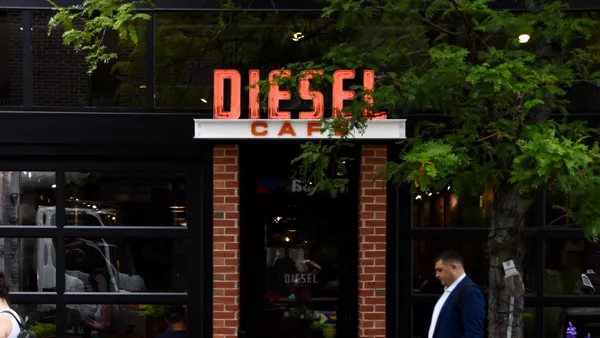Dive Brief:
- Foot traffic at full-service restaurants fell by 4% year-over-year for the week of June 6, while quick-service traffic was up 7.3%, according to a report from Placer.ai.
- Traffic at QSRs has outpaced full-service traffic since the middle of March — just a few weeks after it started to recover following an omicron surge — indicating that consumers are trading down as high gas prices and other inflationary pressures linger.
- At the end of 2021, diners sought out higher-priced restaurants compared to pre-pandemic searches, and full-service restaurant traffic outpaced QSRs, rising as high as 53% during the week of Dec. 13.
Dive Insight:
QSRs with drive-thrus typically tend to take a sales hit when gas prices surge and consumers drive less. But the category may be more insulated than in the past because its prices have indexed lower than both full-service and food-at-home, the latter of which rose 11.9% in the last 12 months.
In May, full-service menu prices increased by 9% year-over-year — a record — while prices in the QSR category are up by 7.3% versus last year, according to U.S. Bureau of Labor Statistics data. But menu prices don’t appear to be deterring customers from going to chains like McDonald’s and Chipotle, Placer.ai found.
McDonald’s and Chipotle both experienced an increase in visits of over 17% during the week of June 6 when national average gas prices surpassed $5. Both concepts have raised their menu prices — McDonald’s by about 8% year over year and Chipotle by about 10% year over year — at a pace higher than most other brands in the industry. Their continued traffic lifts indicate consumers still want to dine out despite significant inflationary pressures, and that consumers perceive both chains to provide a strong value proposition.
McDonald’s is focused on making sure customers get a good value for their money, “particularly in regards to the landscape around us,” McDonald’s President of International Ian Borden said during the Evercore ISI Consumer and Retail Conference earlier this month. The company leverages third-party advisers and consumer surveys to ensure it is pricing competitively, executives said.
That’s not to say full-service concepts aren’t adopting similar measures, however, which could mean the traffic lift at both McDonald’s and Chipotle also likely indicates consumers define value to mean convenient. With its ubiquitous footprint of over 13,000 restaurants in the U.S., McDonald’s provides such convenience, as does Chipotle, which has its robust digital access. In order to maintain traffic, meeting consumers’ definition of value, whatever that may be, is going to become even more critical as the current inflationary environment isn’t expected to ease anytime soon.














